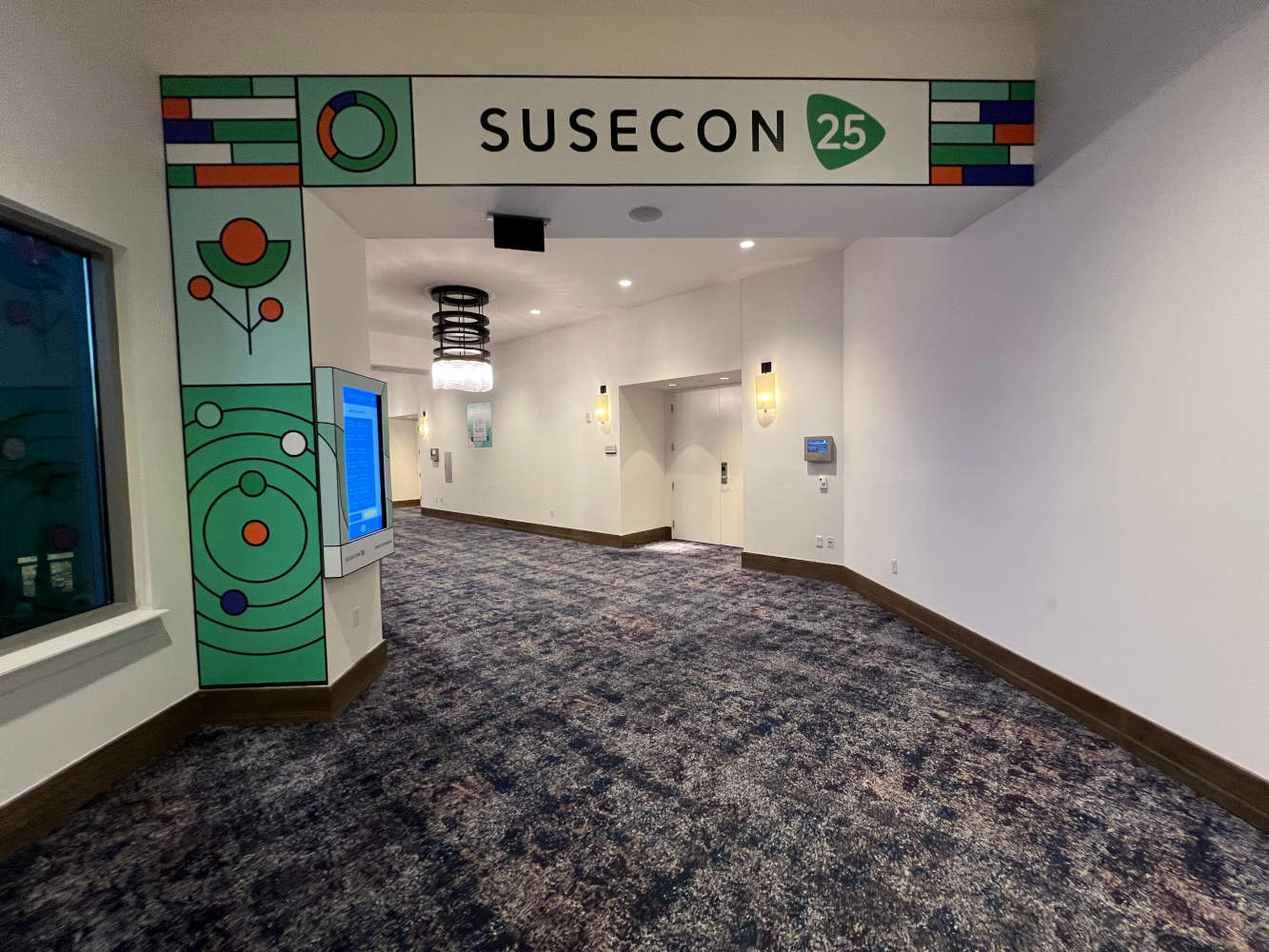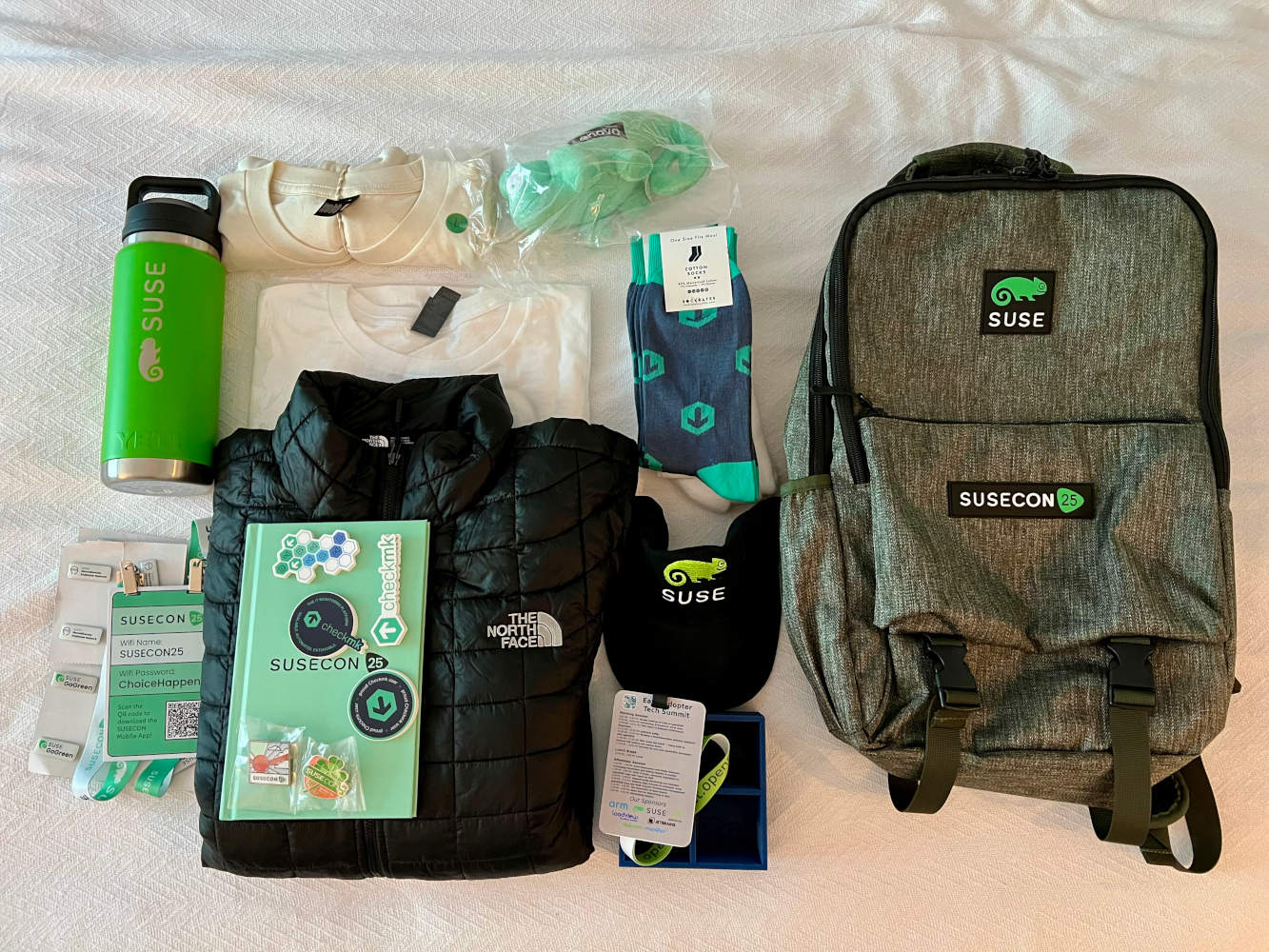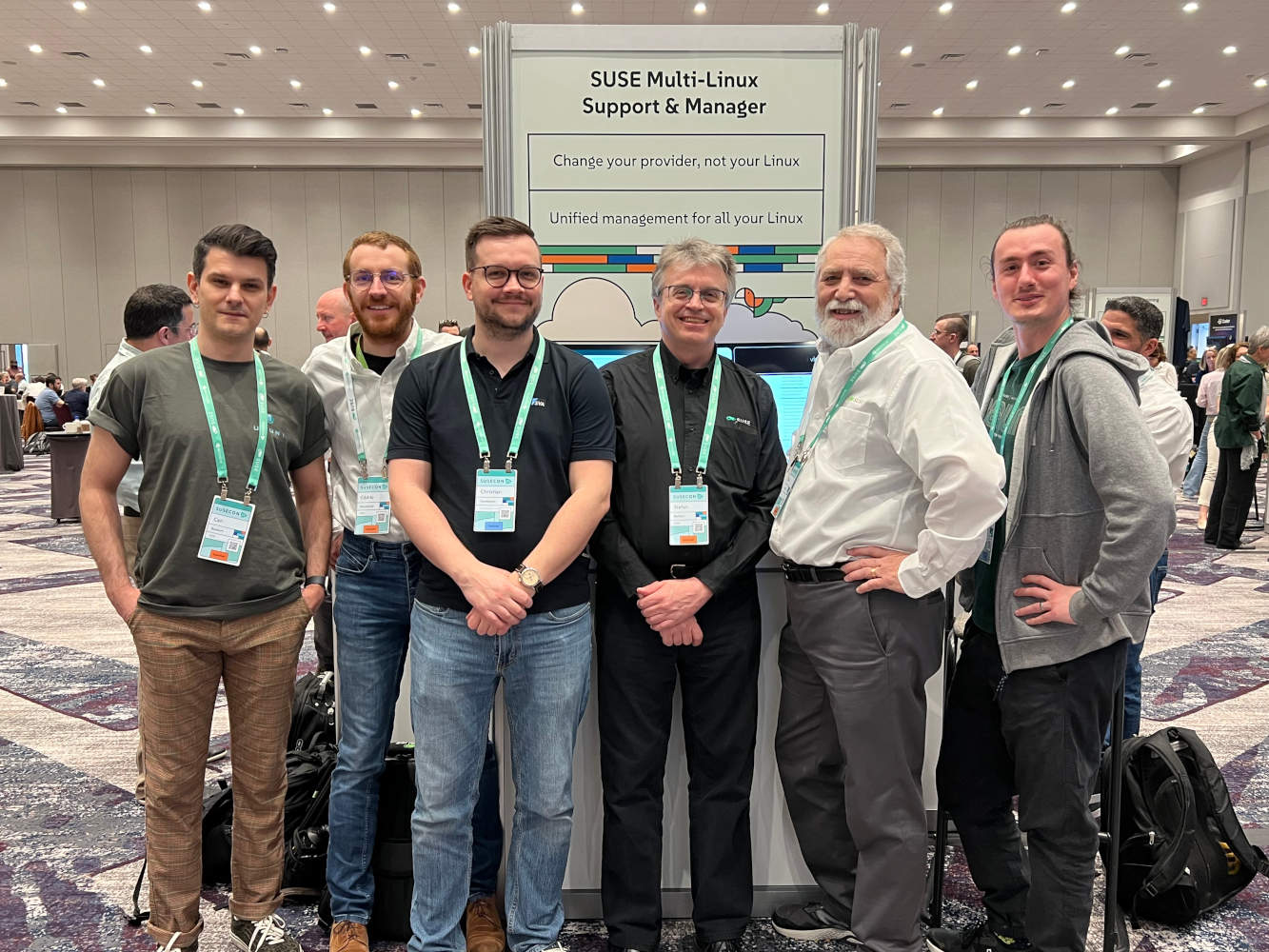SUSECON 2025

From 10.03 to 14.03.2025 the SUSECON took place in Orlando. Compared to the previous iteration of the conference, the 13th event of its kind lasted almost 2 days longer. The first day consisted of an exclusive event for partners, the last day ended for most participants at noon after some final presentations. The motto was once again "Choice happens".
On the occasion of SUSECON 2025, a special was published in the FOCUS ON: Linux-Podcast. In addition to a Recap, there is also an Interview with parts of the SUSE Multi-Linux Manager team.
Location

The event took place at Loews Sapphire Falls Resort - in the immediate vicinity of Universal Orlando Resort.
Approximately 450 participants had the choice between 149 lectures and tutorials - 22 more than last year. The opportunity to take free exams was also offered. I took advantage of this option again this time and obtained a new SUSE Multi-Linux Manager certification. Compared to the conference held in Berlin, the number of participants has almost halved. One of the reasons for this, I was told, is that the SUSE community is more Eurocentric and the US events are therefore generally less well attended. For some participants, however, the current geopolitical situation may also have influenced their decision.
Once again this year, there was an event app for Android and iOS. This made it easier to create a personalised agenda and assisted with navigation within the location using a map - indoor navigation would be an exciting addition for the next conference. This year there was fortunately a store again, where merchandise could be purchased at very fair prices. Popular giveaways (T-shirts, stickers, socks and other swag) were available in the exhibition area - the obligatory conference rucksack was once again of impressive quality.

In the exhibition area there were not only manufacturers and partners, but also stands of the respective products (including SUSE Multi-Linux Manager, openSUSE, SLES,...), which were supervised by experts. I found the direct exchange very valuable.






Keynotes
With the exception of the last day, all days started with morning keynotes. To my chagrin, the omnipresent topic of AI has not flattened out this year either. However, this is not a criticism I level at SUSE in particular, but at large parts of the industry. During the keynotes, no opportunity was missed to emphasise the added value of our own SUSE AI - however, concrete use cases and technical details far removed from the buzzwords were also neglected this year. Increased interest in generative AI and ChatGPT-like applications was attested. Here, SUSE emphasised not only the efficiency of its own products but also the freedom of choice at all times, which counteracts the usual vendor lock-in.
In further sessions, exemplary customers were presented as references. The reasons for these decisions were discussed in short talks - but unfortunately with no or very superficial technical reference. In between, the importance of partnerships was repeatedly emphasised using the example of numerous manufacturers such as AWS, Microsoft and SAP.




Unfortunately, contrary to tradition, there was no music parody this year - but last year's videos were part of the keynote openings:
- "Make Choice Happen 4 Me" ("Jack Harlow - Loving On Me")
- "The Edge" ("R.E.M. - It's The End Of The World As We Know It")



SLES
With SLES 15 SP7, the last service pack of version 15 will be released shortly. The general support ends in July 2031 - if desired, additional support is available until December 2037. This is remarkable considering that SLES 15 was first released in July 2018 - so in total up to 19 years of support was offered.
The next major version SLES 16, which was already mentioned last year, will have to wait a few months longer. The public Beta is planned for this year in May, the release candidate could appear in August - the finished version will appear in November.
Compared to previous versions, SLES 16 is characterised by a simpler build process. This is primarily recognisable through a life cycle independent of the operating system for individual programming languages and stacks - as is already the case with the upstream projects. This means that individual packages are updated more frequently and do not have to be maintained over the entire support period. This should simplify the work of maintainers in particular and also benefit users - after all, what user really needs a PHP version that is 8 years out of date?
A migration of SLE 11, 12 and 15 as well as RHEL/CentOS should be made possible. This process will only be possible as an offline migration and will probably require a dedicated tool. SLE 11 and 12 must first be updated to SLE 15.
One of the most noticeable changes is the new installer Agama based on the Cockpit project. This is a completely new development and breaks with the (Auto)YaST tradition. Whilst individual previous modules can continue to be used, Agama can be integrated more easily into third-party interfaces. A major criticism of YaST is its poor coexistence with common configuration tools such as Ansible. The new framework offers an HTTP interface, a REST API and a CLI. Installation media start a web browser in kiosk mode and thus present the installer. With the right network configuration, this can also be easily displayed on a remote system - eliminating the need for VNC.
There is also a stronger focus on Ansible and SaltStack as widely used configuration management tools - SUSE delivers Ansible content created in collaboration with SAP LinuxLab for Day 1 and 2 operations (e.g. for HA cluster setups). The publication of further content in the Ansible Galaxy or a separate registry is being considered. SaltStack will remain a central component of SUSE Multi-Linux Manager.
The switch from AppArmor to SELinux was already announced last year. Instead of Xen, only KVM will be offered as a hypervisor technology in future. The naming scheme of Point Releases has also changed: the Service Packs known since the introduction of SLES have been dropped. In future, Minor Releases (e.g. 16.1) will be used for versioning, similar to the openSUSE project, which will be released annually in November.
In my opinion, SUSE is doing everything right with the decisions it has made. YaST was increasingly becoming a problem in an automated world and AppArmor does not offer the required level of security on servers. The new installer looks very tidy and the interfaces offered integrate well into the current infrastructure.
SUSE Multi-Linux Manager 5.1
Once again this year, there were some exciting news about the in-house patch management tool. The most striking is probably the new name Multi-Linux Manager, which emphasises the unique selling point: in addition to SUSE distributions, numerous other Linux derivatives (e.g. Debian, Ubuntu or Red Hat-like) can also be managed. With the exception of ATIX orcharhino, no patch management tool designed purely for Linux offers this option. The new name applies to new product versions, older versions remain under the old branding.
Ready-made VM images based on SUSE Linux Micro 6.1 will be offered for the version 5.1 planned for June. Compared to the previous version, which was still based on SLE Micro 5.5, this now also means official support for IBM POWER - previously there was only a barely documented custom build in the download area.
The containerisation introduced with version 5.0 still exists - the option to install the application as a module under SLES 15 SP7 has been added. The Podman container engine is then also used here. This should particularly benefit customers who have previously shied away from the immutable approach. However, it should be noted that a SLES subscription is required for this, as the Multi-Linux Manager subscription only includes SUSE Linux Micro.
The upcoming version will feature a significantly improved RBAC concept in order to be able to assign authorisations more granularly. To this end, namespaces will be introduced, which structure individual authorisations in a tree structure. For the first time, own roles can also be defined.
Four years ago, SUSE Manager 4.2 introduced experimental Ansible support, which has also been covered by support since 4.3, but has not been significantly developed since then. There is a rudimentary web interface in which Ansible inventories can be created and playbooks assigned. Dedicated Ansible control nodes then execute the desired Ansible logic triggered via SaltStack. The biggest point of criticism so far has been the Ansible version 2.9 used, which is no longer suitable for executing current Ansible code.
With the new version, Ansible will be upgraded to a new version that is also compatible with Ansible Galaxy. Editing variables will be possible, as will the recurring execution of playbooks. Further optimisations are to follow in the future. Multi-Linux Manager is not intended to be an alternative to AWX or Semaphore UI, but rather to incentivise smaller environments to use automation. The SaltStack Formulas integration is repeatedly praised, but the IaC software - not least due to developments since the takeover by Broadcom - is enjoying less and less maintenance and distribution.
SaltStack will continue to be an essential part of the product, as it is used for communication with registered systems. It is also part of the identity of the Uyuni project, which takes its name from Bolivia's largest salt desert.
SUSE Manager 4.3 and 5.0 will be supported until June 2026, giving customers enough time to migrate. A direct migration from 4.3 to 5.1 will be made possible. It is planned to support Multi-Linux Manager 5.1 until June 2028, with the successor version 5.2 due to be released in June 2026.
Some highlights of the current roadmap were shown in a session. For example, the container image, which currently contains all the required components (Apache, Tomcat, PostgreSQL, Java), is to be split into dedicated images in future. One advantage of this would be that the application can be operated on Kubernetes in the future and individual components can be tested and further developed more easily. The proxy server has also been available for some time via a Helmchart.
Another welcome development is the evaluation of OpenAPI. The free API specification can be used with tools such as Swagger to automatically generate programme code that interacts with your own API. This could drastically simplify integration into third-party tools such as Ansible and Terraform. The Foreman project has used this approach to develop a comprehensive Ansible collection.
Although there is currently already extensive API documentation, this is in a format that cannot easily be parsed automatically. It is therefore necessary to rebuild the corresponding backend code - some of which dates back to the early Spacewalk days.
I am looking forward to the new product version. I welcome the option of offering the tool as a conventional SLES module in the future. I have carried out numerous migrations in recent months and have noticed that some customers still have problems with immutable distributions - in particular, the significantly smaller package selection often clashes with required older third-party applications, such as backup and monitoring agents.
SUSE Multi-Linux Support
With SUSE Multi-Linux Support, the offer formerly known as SUSE Liberty Linux has also been given a new name. The basic idea of the offer is to be able to obtain patches for CentOS and Red Hat Enterprise Linux in versions 7 to 9 via SUSE. This results in cost savings on the one hand and the elimination of dependency on Red Hat, which was emphasized several times during the keynote. A project at Deutsche Bank, which has converted more than 10,000 systems in this way, served as a reference. To my mind, however, this is not particularly surprising, as technically nothing worth mentioning changes. The main change is the repository URLs: the packages are compiled, tested and supported by SUSE instead of Red Hat. Multi-Linux support will also be offered for the soon-to-be-released RHEL 10.
The offer is primarily aimed at customers willing to migrate who have not yet managed to reconcile the life cycle of the distribution used with the project business. This is not meant to sound disparaging, but the end of RHEL 7 and CentOS 7 was already foreseeable when they were launched in 2014. 10 years of standard support or 13 years when booking the Extended Lifecycle Support (ELS) at extra cost should be enough to adequately replace even critical systems. Red Hat even countered the problem with an additional year of ELS support - so a total of 14 years is conceivable. However, replacing the technical debt has its price, which is why this is a lucrative business for SUSE.
Rancher
Rancher is SUSE's in-house Kubernetes platform, which has been a permanent part of the portfolio since the acquisition of Rancher Labs in July 2020.
The biggest highlight was the announcement of a private container registry based on the Harbor project. Previously, a dedicated registry always had to be operated - now it is included, at least for Rancher Prime customers.
Another exciting new feature was virtual clusters - for example for development or validation scenarios. The k3k project (Kubernetes in Kubernetes) is used for this. As this project currently still has experimental status, this function is also considered a technical preview.
With SUSE Unified Core, a unified stack consisting of SUSE Linux Micro and RKE2 was introduced. The release is planned for November 2025.
With SUSE Application Collection, a registry for containerized applications was introduced, which is primarily intended to drastically simplify deployment. Created as a catalog, you can search specifically for tested helmcharts. The offering is currently under active development and is reserved for Rancher Prime customers. It can currently be evaluated free of charge for 30 days via the AWS Marketplace.
SUSE Virtualization
Harvester has also been given a new product name, which should make its purpose easier to understand. With the platform, SUSE continues to offer a hyperconverged infrastructure solution for VM and container workloads. It was emphasized that the tool is not a 1:1 replacement for VMware vSphere scenarios - it is rather aimed at modern cloud-native environments and benefits the general modernization of the infrastructure.
The highlights include some changes in the storage area. While external CSI storage has been able to be connected for some time, it is now also possible to store system hard disks of managed VMs on external storage. Another new feature is that storage providers are now also certified by SUSE. Initially, four providers were released: Portworx, Dell, Oracle and NetApp. Another novelty: the upcoming version 1.5 offers volume encryption.
A no less interesting highlight of the new version is official ARM support. This makes SUSE Virtualization one of the few virtualization platforms that fully support ARM. For some time, there was a non-officially supported ESXi version of vSphere that could be operated on ARM devices. Since the takeover by Broadcom, however, development has been quiet.
With Rancher for SAP, a special variant for SAP customers was introduced, which differs primarily in terms of support and can be used for specific SAP applications.
Networking
Even if the lecture program is extensive, I attend conferences for another reason: to exchange ideas with the people behind the individual projects and other participants. Presentations can usually be watched online afterwards - exciting presentations usually take place at the same time anyway. I therefore try to only attend the sessions I want to ask questions about.
The evening event on the third day took place at the nearby City Walk and invited people to network with a wide range of culinary delights and varied activities.
One highlight for me was meeting some of the SUSE Manager Team again. We were able to discuss current developments with Cedric Bosdonnat and Can Bayburt, among others. We were able to interview Stefan Behlert and Don Vosburg again - it was a real pleasure!

Beside the conference
If time permits, it is advisable to explore the surrounding area - ideally by car. The city centre of Orlando is approx. 20 km away. Possible destinations if you add one or more days of holiday to your conference visit are
- Daytona Beach (approx. 1.5 hours away)
- Tampa (1.5 hours)
- Miami (4.5 hours)
- Everglades National Park (6 hours)
Within walking distance of the Loews Sapphire, however, there are also some sightseeing attractions:
- Universal CityWalk
- Hard Rock Hotel and Hard Rock Cafe
- Universal Studios and Islands of Adventure
The latter is suitable if you are a film nerd, have a free day and enough waiting time and money.





Conclusion
Despite the omnipresent hymns of praise for AI, I enjoyed the conference again this year. The content of the numerous keynotes could have been condensed or - much better - enriched with more technical details. Above all, the networking with participants and developers was very valuable. I'm already looking forward to the upcoming SUSE Multi-Linux Manager 5.1 and SLE 16 releases. The event app is a welcome addition to the website, even if it unfortunately stopped working properly on the last day.
My wish for the next SUSECON is what I wish for other conferences: less buzzword battles, more technical details and practical use cases.
SUSE has already announced that the next SUSECON 2026 will take place in Prague.